- Accueil
- Pages cachées
- 23 JUILLET 2023 NEWS
23 JUILLET 2023 NEWS
INSTITUT SUPERIEUR D'ANTHROPOLOGIE
INSTITUTE OF ANTHROPOLOGY
ONLINE COURSES / COURS A DISTANCE
DEBUT COURS : SEPTEMBRE 2023
REGISTER NOW
RUSSIE – 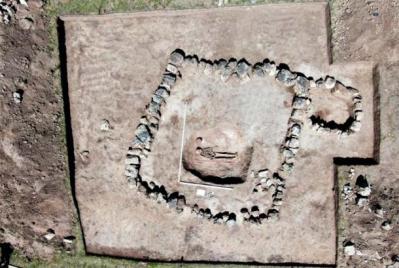
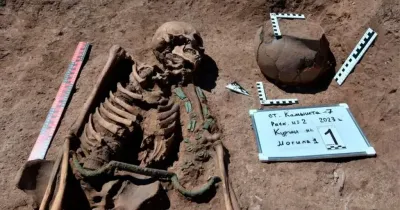 Askizsky - Russian archaeologists uncovered the grave of a Late Bronze Age man buried wearing a “charioteer’s belt”, a flat bronze plate with two curved hooks at the end reminiscent of a yoke used to harness draft animals, during a rescue archaeology excavation at the railway expansion site in the Askizsky region of Khakassia, in Southern Siberia. This tool is thought to have been used by charioteers to cinch their reins to their waists, freeing up their hands for battle. This type of artifact has also been found in Chinese and Mongolian graves. The tomb is dated to between the 11th and the 8th century B.C., a time when the Lugav culture was dominant in the area. Archaeologists and historians didn’t believe chariots were being used in this part of Asia that long ago. Aleksey Timoshchenko, an archaeologist at the Institute of Archaeology and Ethnography of the Russian Academy of Sciences, told Live Science in an email that the object was found in its original placement at the waist of the person in the undisturbed grave. This device was actually designed to be attached to a charioteer’s belt. The charioteer could rest their hands while controlling the horses pulling the chariot by wrapping the reins around the belt. This was an item of convenience for a charioteer and its telltale appearance leaves no question as to the identity of the deceased person who was buried with it. The charioteer’s tomb is a square masonry tomb with an earthen mound built on top of it. The deceased was buried with a bronze knife, bronze jewelry, including a necklace with rectangular pendants typical of Lugav culture, and a belt. The site under excavation contains material remains of a cemetery as well as a settlement from this period, and the Lugav barrows in the cemetery can be grouped into three stages — the transition to the Lugav culture, the Lugav middle stage, and the late stage, when characteristics from the next culture (Tagar) appear mingled with the Lugav features. The charioteer’s tomb is from the middle stage.
Askizsky - Russian archaeologists uncovered the grave of a Late Bronze Age man buried wearing a “charioteer’s belt”, a flat bronze plate with two curved hooks at the end reminiscent of a yoke used to harness draft animals, during a rescue archaeology excavation at the railway expansion site in the Askizsky region of Khakassia, in Southern Siberia. This tool is thought to have been used by charioteers to cinch their reins to their waists, freeing up their hands for battle. This type of artifact has also been found in Chinese and Mongolian graves. The tomb is dated to between the 11th and the 8th century B.C., a time when the Lugav culture was dominant in the area. Archaeologists and historians didn’t believe chariots were being used in this part of Asia that long ago. Aleksey Timoshchenko, an archaeologist at the Institute of Archaeology and Ethnography of the Russian Academy of Sciences, told Live Science in an email that the object was found in its original placement at the waist of the person in the undisturbed grave. This device was actually designed to be attached to a charioteer’s belt. The charioteer could rest their hands while controlling the horses pulling the chariot by wrapping the reins around the belt. This was an item of convenience for a charioteer and its telltale appearance leaves no question as to the identity of the deceased person who was buried with it. The charioteer’s tomb is a square masonry tomb with an earthen mound built on top of it. The deceased was buried with a bronze knife, bronze jewelry, including a necklace with rectangular pendants typical of Lugav culture, and a belt. The site under excavation contains material remains of a cemetery as well as a settlement from this period, and the Lugav barrows in the cemetery can be grouped into three stages — the transition to the Lugav culture, the Lugav middle stage, and the late stage, when characteristics from the next culture (Tagar) appear mingled with the Lugav features. The charioteer’s tomb is from the middle stage.
https://arkeonews.net/3000-year-old-charioteer-belt-discovered-in-siberia/
PEROU – 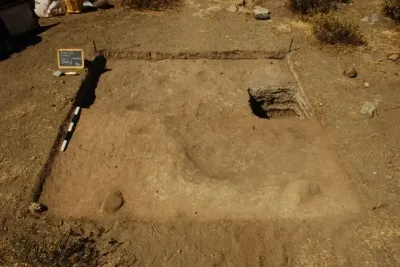 Viejo Sangayaico - Archaeologists have discovered an ancient “sounding” dance floor in Peru that was designed to create a drum-like sound when stepped on, perhaps for a thunder god. The floor was constructed into an open-air platform at Viejo Sangayaico, 200 km southeast of Lima, sometime between AD 1000 and AD 1400. From 1400 to 1532, it was still in use under Inca rule, and possibly in the early years of the Spanish conquest. “I believe that these open platforms would have been used during the pre-Hispanic period as a stage on which to venerate the nearby mountain gods, in this case those of Huinchocruz,” Lane explains. According to archaeologists, the Viejo Sangayaico dance floor was created as a way to mimic the mesmerizing sound of thunder, drawing on the Andean belief system that connected lightning deities with rain and thunder. The platform’s unique design consists of four layers of carefully prepared fills, and a diverse array of materials was designed to enhance the percussive sound. These layers were made up of camelid guano and clean silty clay, which were strategically interspersed to achieve the desired percussion effect. The carefully placed gaps within the dung layers contributed to the creation of a deep, bass-like sound that encircled the dance floor, which was approximately 10 meters (32.8 ft) in diameter.
Viejo Sangayaico - Archaeologists have discovered an ancient “sounding” dance floor in Peru that was designed to create a drum-like sound when stepped on, perhaps for a thunder god. The floor was constructed into an open-air platform at Viejo Sangayaico, 200 km southeast of Lima, sometime between AD 1000 and AD 1400. From 1400 to 1532, it was still in use under Inca rule, and possibly in the early years of the Spanish conquest. “I believe that these open platforms would have been used during the pre-Hispanic period as a stage on which to venerate the nearby mountain gods, in this case those of Huinchocruz,” Lane explains. According to archaeologists, the Viejo Sangayaico dance floor was created as a way to mimic the mesmerizing sound of thunder, drawing on the Andean belief system that connected lightning deities with rain and thunder. The platform’s unique design consists of four layers of carefully prepared fills, and a diverse array of materials was designed to enhance the percussive sound. These layers were made up of camelid guano and clean silty clay, which were strategically interspersed to achieve the desired percussion effect. The carefully placed gaps within the dung layers contributed to the creation of a deep, bass-like sound that encircled the dance floor, which was approximately 10 meters (32.8 ft) in diameter.
ESPAGNE – 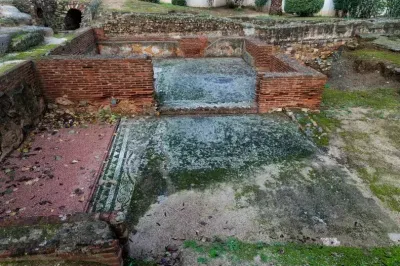 Merida – A "huge" public bath area from the Roman era has been discovered in Spain in "excellent" condition. Archaeologists made the discovery in the city of Mérida—capital of the Extremadura region in the western-central part of the Iberian Peninsula. Mérida is home to a UNESCO World Heritage site that contains the remarkably well-preserved remains of an ancient Roman colony, Augusta Emerita, which was the predecessor of the modern city. The latest discovery in Merida was uncovered in the Casa del Anfiteatro (House of the Amphitheater)—a site located close to the theater and amphitheater. The "huge" public bath space is in an "excellent" state, Félix Palma, director of the Consortium of the Monumental City of Mérida, told Spanish news agency. The baths are "perfectly preserved"—complete with decorations such as marble plaques, moldings on the cornices, paintings on the walls, and all of their underground structures, said archaeologist Ana María Bejarano, who was involved in the excavations. The site of the discovery lies in an archaeological area that was originally located outside the walls of Augusta Emerita. The area includes homes, funerary and industrial spaces, as well as two notable houses— the Casa de la Torre del Agua (House of the Water Tower) and the Casa del Anfiteatro.The Casa del Anfiteatro was a large residence that includes a courtyard, a kitchen and a mosaic floor depicting scenes of the grape harvest.
Merida – A "huge" public bath area from the Roman era has been discovered in Spain in "excellent" condition. Archaeologists made the discovery in the city of Mérida—capital of the Extremadura region in the western-central part of the Iberian Peninsula. Mérida is home to a UNESCO World Heritage site that contains the remarkably well-preserved remains of an ancient Roman colony, Augusta Emerita, which was the predecessor of the modern city. The latest discovery in Merida was uncovered in the Casa del Anfiteatro (House of the Amphitheater)—a site located close to the theater and amphitheater. The "huge" public bath space is in an "excellent" state, Félix Palma, director of the Consortium of the Monumental City of Mérida, told Spanish news agency. The baths are "perfectly preserved"—complete with decorations such as marble plaques, moldings on the cornices, paintings on the walls, and all of their underground structures, said archaeologist Ana María Bejarano, who was involved in the excavations. The site of the discovery lies in an archaeological area that was originally located outside the walls of Augusta Emerita. The area includes homes, funerary and industrial spaces, as well as two notable houses— the Casa de la Torre del Agua (House of the Water Tower) and the Casa del Anfiteatro.The Casa del Anfiteatro was a large residence that includes a courtyard, a kitchen and a mosaic floor depicting scenes of the grape harvest.
https://www.newsweek.com/huge-roman-public-baths-excellent-state-discovered-spain-1814506
USA –  - Vernon Parish - Long buried under the woods of west central Louisiana, stone tools, spearpoints and other evidence of people living in the area as long as 12,000 years ago have become more exposed and vulnerable, due to hurricanes, flooding and looters. This summer, archaeologists have been gingerly digging up the ground at the Vernon Parish site in the Kisatchie National Forest. They have been sifting through dirt to unearth and preserve the evidence of prehistoric occupation of the area.“The site appears to have been continuously occupied throughout prehistory, as evidenced by a wide range of stone tools and pottery dating to each Native American cultural era up to European contact,” the U.S. Forest Service said in an news release.
- Vernon Parish - Long buried under the woods of west central Louisiana, stone tools, spearpoints and other evidence of people living in the area as long as 12,000 years ago have become more exposed and vulnerable, due to hurricanes, flooding and looters. This summer, archaeologists have been gingerly digging up the ground at the Vernon Parish site in the Kisatchie National Forest. They have been sifting through dirt to unearth and preserve the evidence of prehistoric occupation of the area.“The site appears to have been continuously occupied throughout prehistory, as evidenced by a wide range of stone tools and pottery dating to each Native American cultural era up to European contact,” the U.S. Forest Service said in an news release.
ISRAEL –
 Haifa – A new study published by the Israel Antiquities Authority sheds light on a 900-year-old sword discovered in the sea. The discovery of the sword attracted enormous interest and was reported in many media outlets worldwide. The sword was covered in a thick marine concretion of sand and shells, making it difficult to separate it from the metal without causing damage. “It's unfortunate that we can’t see the sword as it was,” the researchers say in the latest issue of the 'Atiqot' Journal. “On the other hand, the concretion is responsible for slowing down the oxidation process, preserving the sword in its entirety. Otherwise, the iron would have rusted and disintegrated in the water.” Cutting-edge X-ray technology made it possible to visually penetrate the layers of marine concretion and take a glimpse at the sword's original shape. “The sword was used by a Crusader who settled in the area following the First Crusade and established the Kingdom of Jerusalem in 1099," Sharvit said. “Considering the battles that took place here between the Crusaders and the Muslims, known from several historical sources, we could expect to find more swords." The study revealed that the sword, with an 88 cm long and 4.6 cm wide blade, was probably used in combat, as the X-ray examination showed that it was bent. “The sword was part of a knight’s or warrior’s personal equipment. It was the main weapon in hand-to-hand combat in those days,” says Gosker. “Swords required a lot of quality iron and were therefore expensive. In addition, sword fighting required training and practice and, therefore, only nobility and professional soldiers fought using them.” Researchers estimate that the sword fell into the sea during a battle – perhaps between naval vessels. “Being expensive, swords are usually found within a scabbard. In this case, only the sword itself was found. From this, we can infer that it fell into the sea during a battle, possibly along with its owner," according to the study.
Haifa – A new study published by the Israel Antiquities Authority sheds light on a 900-year-old sword discovered in the sea. The discovery of the sword attracted enormous interest and was reported in many media outlets worldwide. The sword was covered in a thick marine concretion of sand and shells, making it difficult to separate it from the metal without causing damage. “It's unfortunate that we can’t see the sword as it was,” the researchers say in the latest issue of the 'Atiqot' Journal. “On the other hand, the concretion is responsible for slowing down the oxidation process, preserving the sword in its entirety. Otherwise, the iron would have rusted and disintegrated in the water.” Cutting-edge X-ray technology made it possible to visually penetrate the layers of marine concretion and take a glimpse at the sword's original shape. “The sword was used by a Crusader who settled in the area following the First Crusade and established the Kingdom of Jerusalem in 1099," Sharvit said. “Considering the battles that took place here between the Crusaders and the Muslims, known from several historical sources, we could expect to find more swords." The study revealed that the sword, with an 88 cm long and 4.6 cm wide blade, was probably used in combat, as the X-ray examination showed that it was bent. “The sword was part of a knight’s or warrior’s personal equipment. It was the main weapon in hand-to-hand combat in those days,” says Gosker. “Swords required a lot of quality iron and were therefore expensive. In addition, sword fighting required training and practice and, therefore, only nobility and professional soldiers fought using them.” Researchers estimate that the sword fell into the sea during a battle – perhaps between naval vessels. “Being expensive, swords are usually found within a scabbard. In this case, only the sword itself was found. From this, we can infer that it fell into the sea during a battle, possibly along with its owner," according to the study.
https://www.ynetnews.com/travel/article/r1j9spic3
TURQUIE – 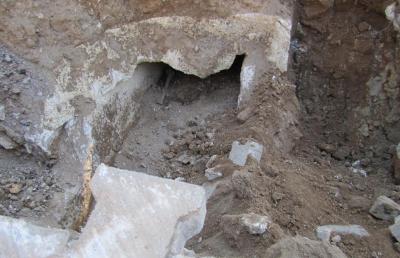 Denizli - In an unexpected turn of events during a natural gas excavation in Denizli, western Turkey, an ancient sarcophagus has been unearthed, leaving archaeologists and historians intrigued by its potential historical significance. As the construction machine's bucket delved into the ground, it unexpectedly snagged the lid of the sarcophagus, putting the excavation on hold. Highlighting the historical significance of the region, the mayor noted that it is home to the Tabea Ancient City. To ascertain more about the sarcophagus's historical attributes, experts from the Denizli Museum Directorate will meticulously examine the find.
Denizli - In an unexpected turn of events during a natural gas excavation in Denizli, western Turkey, an ancient sarcophagus has been unearthed, leaving archaeologists and historians intrigued by its potential historical significance. As the construction machine's bucket delved into the ground, it unexpectedly snagged the lid of the sarcophagus, putting the excavation on hold. Highlighting the historical significance of the region, the mayor noted that it is home to the Tabea Ancient City. To ascertain more about the sarcophagus's historical attributes, experts from the Denizli Museum Directorate will meticulously examine the find.
ECOSSE – 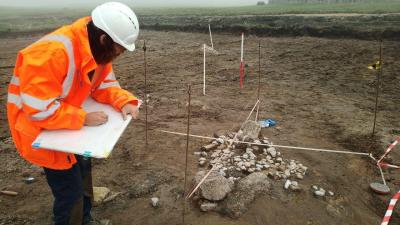 Lamba Ness - The remains of what may have been an Early Bronze Age ritual cremation cemetery have been found on the SaxaVord Spaceport site. The discovery was made during groundworks for the next phase of Europe’s premier rocket launch site on the Lamba Ness peninsula in Unst, Shetland. Several features, including pits, large boulders and cremations (or deposits of burnt bone) have been uncovered along with a quartz setting – which is often associated in prehistory with burial tombs. Excavation is at a very early stage, but the hypothesis of the archaeologists working on the site is that the remains may date from around 2200-1800 BC.
Lamba Ness - The remains of what may have been an Early Bronze Age ritual cremation cemetery have been found on the SaxaVord Spaceport site. The discovery was made during groundworks for the next phase of Europe’s premier rocket launch site on the Lamba Ness peninsula in Unst, Shetland. Several features, including pits, large boulders and cremations (or deposits of burnt bone) have been uncovered along with a quartz setting – which is often associated in prehistory with burial tombs. Excavation is at a very early stage, but the hypothesis of the archaeologists working on the site is that the remains may date from around 2200-1800 BC.
https://news.stv.tv/highlands-islands/saxavord-spaceport-early-bronze-age-discovery-made-on-shetland
ANGLETERRE – 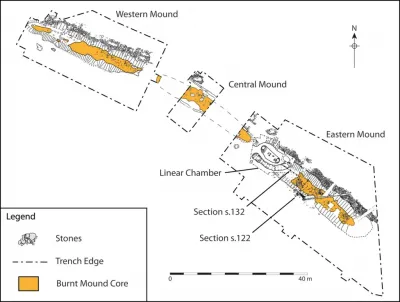 Herefordshire - Archaeologists discovered a remarkable complex of early Neolithic monuments while investigating the area around Dorstone Hill in Herefordshire, England. The Early Neolithic monuments complex: consists of three long barrows constructed on the footprints of three timber buildings that had been deliberately burned and plus a nearby causewayed enclosure. Researchers used advanced radiocarbon dating to investigate the age of Neolithic monuments and the results showed the structures were much older than expected. The dating shows that at least 5,800 years ago, the area was inhabited by Neolithic people, who engaged in farming and the construction of monuments rather than hunting and gathering. This would make Dorstone Hill the earliest culturally Neolithic site in the west Midlands of England, comparable with early dates from Penywyrlod and Gwernvale in the Black Mountains of Wales. These early dates, so far inland, suggest that Neolithic practices did not spread evenly from south-east to north-west across Britain, as has sometimes been suggested, but instead moved somewhat irregularly, with pockets of hunter-gatherers and farmers sometimes co-existing for hundreds of years.
Herefordshire - Archaeologists discovered a remarkable complex of early Neolithic monuments while investigating the area around Dorstone Hill in Herefordshire, England. The Early Neolithic monuments complex: consists of three long barrows constructed on the footprints of three timber buildings that had been deliberately burned and plus a nearby causewayed enclosure. Researchers used advanced radiocarbon dating to investigate the age of Neolithic monuments and the results showed the structures were much older than expected. The dating shows that at least 5,800 years ago, the area was inhabited by Neolithic people, who engaged in farming and the construction of monuments rather than hunting and gathering. This would make Dorstone Hill the earliest culturally Neolithic site in the west Midlands of England, comparable with early dates from Penywyrlod and Gwernvale in the Black Mountains of Wales. These early dates, so far inland, suggest that Neolithic practices did not spread evenly from south-east to north-west across Britain, as has sometimes been suggested, but instead moved somewhat irregularly, with pockets of hunter-gatherers and farmers sometimes co-existing for hundreds of years.
https://arkeonews.net/complex-of-early-neolithic-monuments-discovered-in-herefordshire-england/
VIET NAM – 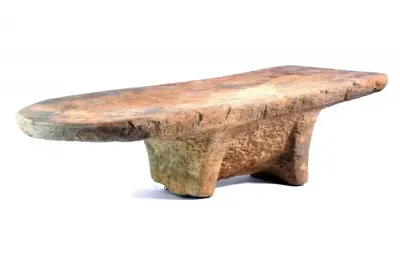 Oc Eo - Archaeologists have found remnants of eight spices on a sandstone slab from an archaeological site in Vietnam, showing the early adoption of ingredients and techniques from South Asia. Unearthed in an ancient village in southern Vietnam, the cookware—roughly the size and shape of an anvil—was likely used to grind the spice and other ingredients familiar in today’s curries. The discovery, reported today in Science Advances, marks the earliest known example of spice processing in mainland Southeast Asia.. It also suggests that millennia ago, visitors from India and Indonesia may have brought their culinary traditions to the region. During their digs at the Oc Eo archaeological site in southern Vietnam, Hsiao-Chun Hung at the Australian National University in Canberra and her colleagues uncovered several sandstone grinding tools alongside remnants of spices. An analysis of 717 grains of starch recovered from the tools revealed the presence of eight different spices: turmeric, ginger, galangal, sand ginger, fingerroot, clove, nutmeg, and cinnamon. Many of the grains also showed signs of deformation, indicating that they had been damaged during grinding and resembled the starch granules found in modern curry powder. Though previous fragments discovered elsewhere predate the spices studied in the new study, the Óc Eo findings provide the first evidence that these spices were all used in Southeast Asia during this time period. The spice remains suggest that the stone mortars, pestles, and grinding slabs discovered there were most likely used for food preparation.
Oc Eo - Archaeologists have found remnants of eight spices on a sandstone slab from an archaeological site in Vietnam, showing the early adoption of ingredients and techniques from South Asia. Unearthed in an ancient village in southern Vietnam, the cookware—roughly the size and shape of an anvil—was likely used to grind the spice and other ingredients familiar in today’s curries. The discovery, reported today in Science Advances, marks the earliest known example of spice processing in mainland Southeast Asia.. It also suggests that millennia ago, visitors from India and Indonesia may have brought their culinary traditions to the region. During their digs at the Oc Eo archaeological site in southern Vietnam, Hsiao-Chun Hung at the Australian National University in Canberra and her colleagues uncovered several sandstone grinding tools alongside remnants of spices. An analysis of 717 grains of starch recovered from the tools revealed the presence of eight different spices: turmeric, ginger, galangal, sand ginger, fingerroot, clove, nutmeg, and cinnamon. Many of the grains also showed signs of deformation, indicating that they had been damaged during grinding and resembled the starch granules found in modern curry powder. Though previous fragments discovered elsewhere predate the spices studied in the new study, the Óc Eo findings provide the first evidence that these spices were all used in Southeast Asia during this time period. The spice remains suggest that the stone mortars, pestles, and grinding slabs discovered there were most likely used for food preparation.
FRANCE – 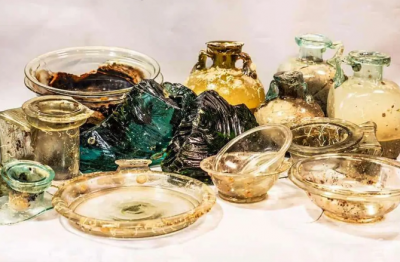 Cap Corse - Capo Corso 2 was first discovered in 2012 at a depth of around 350 metres in the stretch of sea between Capo Corso and the island of Capraia. Preliminary dating places the ship to around the end of the 1st and the early 2nd century AD, which sunk transporting a cargo almost exclusively of glass in both its raw state, and thousands of worked brown tableware. An Italian-French mission first conducted a photogrammetric survey of the wreck to study changes to the site caused by sedimentation and human action. Based on the obtained data, the researchers then deployed a remotely operated vehicle (ROV) called Arthur. Arthur is a new ROV prototype that can reach a depth of 2500 metres. It can shoot high-definition video, ventilate or vacuum the sediment, and recover artefacts in situ by using a specially mounted claw. Various glass objects have been recovered using the ROV, including glass bottles, cups, and bowls, in addition to two bronze basins and several amphorae. In an announcement by the National Superintendency for Underwater Cultural Heritage: “All archaeological materials will be transported to the laboratory of the National Superintendence in Taranto for scientific analyses, for the characterisation of biological degradation and for restoration.”
Cap Corse - Capo Corso 2 was first discovered in 2012 at a depth of around 350 metres in the stretch of sea between Capo Corso and the island of Capraia. Preliminary dating places the ship to around the end of the 1st and the early 2nd century AD, which sunk transporting a cargo almost exclusively of glass in both its raw state, and thousands of worked brown tableware. An Italian-French mission first conducted a photogrammetric survey of the wreck to study changes to the site caused by sedimentation and human action. Based on the obtained data, the researchers then deployed a remotely operated vehicle (ROV) called Arthur. Arthur is a new ROV prototype that can reach a depth of 2500 metres. It can shoot high-definition video, ventilate or vacuum the sediment, and recover artefacts in situ by using a specially mounted claw. Various glass objects have been recovered using the ROV, including glass bottles, cups, and bowls, in addition to two bronze basins and several amphorae. In an announcement by the National Superintendency for Underwater Cultural Heritage: “All archaeological materials will be transported to the laboratory of the National Superintendence in Taranto for scientific analyses, for the characterisation of biological degradation and for restoration.”
TURQUIE – 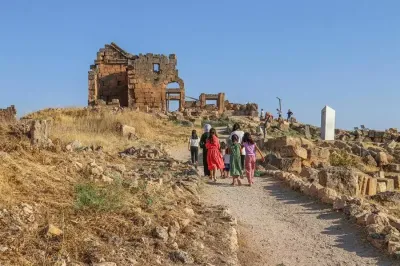 Zerzevan Castle - A series of excavation studies will be launched to gather further information on massive structures recently found under the Zerzevan Castle, a 3,000-year-old Roman garrison in the southeastern province of Diyarbakır. During the ongoing studies, a group of archeologists has recently discovered massive multi-story structures that have the capacity to accommodate thousands of individuals under the historical castle. Aytaç Coşkun, the head of the excavation team, stated that over the past nine years, excavations conducted at regular intervals have revealed the remains of city walls, observation and defense towers, administrative buildings, residences, armories, underground places of worship, cisterns and an 1,800-year-old entrance at Zerzevan Castle. The large-sized structures detected beneath the lower part of the castle are expected to be unearthed through upcoming excavations, Coşkun added. The history of this ancient castle, initially serving as a border garrison for Rome, traces its origins to the Assyrian era. Built as a military settlement in the third century A.D., it continued to serve this purpose until being overtaken by Islamic armies.
Zerzevan Castle - A series of excavation studies will be launched to gather further information on massive structures recently found under the Zerzevan Castle, a 3,000-year-old Roman garrison in the southeastern province of Diyarbakır. During the ongoing studies, a group of archeologists has recently discovered massive multi-story structures that have the capacity to accommodate thousands of individuals under the historical castle. Aytaç Coşkun, the head of the excavation team, stated that over the past nine years, excavations conducted at regular intervals have revealed the remains of city walls, observation and defense towers, administrative buildings, residences, armories, underground places of worship, cisterns and an 1,800-year-old entrance at Zerzevan Castle. The large-sized structures detected beneath the lower part of the castle are expected to be unearthed through upcoming excavations, Coşkun added. The history of this ancient castle, initially serving as a border garrison for Rome, traces its origins to the Assyrian era. Built as a military settlement in the third century A.D., it continued to serve this purpose until being overtaken by Islamic armies.
PORTUGAL – 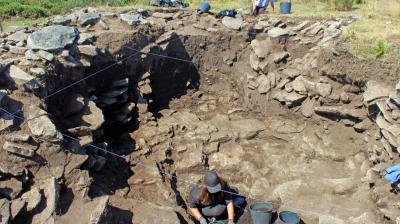 Vila Verde - A team of archaeologists and students from the University of Minho is excavating a recently discovered megalithic funerary monument on top of Monte do Oural, in the municipality of Vila Verde. The objective, according to the municipality, is to ensure the preservation of "a valuable heritage find", whose construction is estimated to have taken place between 4,000 and 3,000 years before Christ (BC), that is, more than 5 thousand years ago. Archaeologist Luciano Vilas Boas, who coordinates the excavation work of the Oural mound on the ground, highlighted on the municipality's website that the surrounding area is extremely rich in terms of archaeological heritage, identifying the existence of three more megalithic monuments of funerary nature and a set of rock art in the surrounding area. With this discovery, it is possible to confirm that there were "various populations" living in this area, located next to the lookout point on the limits of Ribeira do Neiva.
Vila Verde - A team of archaeologists and students from the University of Minho is excavating a recently discovered megalithic funerary monument on top of Monte do Oural, in the municipality of Vila Verde. The objective, according to the municipality, is to ensure the preservation of "a valuable heritage find", whose construction is estimated to have taken place between 4,000 and 3,000 years before Christ (BC), that is, more than 5 thousand years ago. Archaeologist Luciano Vilas Boas, who coordinates the excavation work of the Oural mound on the ground, highlighted on the municipality's website that the surrounding area is extremely rich in terms of archaeological heritage, identifying the existence of three more megalithic monuments of funerary nature and a set of rock art in the surrounding area. With this discovery, it is possible to confirm that there were "various populations" living in this area, located next to the lookout point on the limits of Ribeira do Neiva.
https://www.theportugalnews.com/news/2023-07-22/5000-year-old-funerary-monument-discovered/79738
